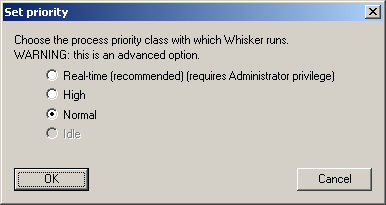Server → Set server priority within Windows
Caution: advanced option

With this dialogue box, you can configure the process priority with which WhiskerServer runs. This sets the 'importance' of the server relative to all the other programs running. The default is real-time. These options are as follows:
| • | Real-time. The highest possible priority. This process pre-empts all other processes, including operating system processes performing tasks. 'An application that runs at this level for more than a very brief interval can, for example, cause disk caches not to flush or cause the mouse to be unresponsive.' [Source: Windows Platform SDK documentation.] This mode requires WhiskerServer to be run with Windows Administrator privileges. |
| • | High. This process pre-empts those running at Normal or Idle levels. Used by applications that must retain rapid responsiveness, re-gardless of the system load. Example: the Windows NT task list. |
| • | Normal. The normal priority. Most processes use this. |
| • | Idle [not allowed]. The process runs only when the system is idle. Example: screen savers. |
You may think that it sounds dangerous to run at the real-time priority. In practice, Whisker does only execute for a very brief interval every time it is called by Windows (every 1 ms or so); if Whisker were to occupy the CPU for longer than the interval, it would in fact 'lock up' the computer completely. To avoid this every happening, Whisker 'yields' control for a brief period every time it is called, to ensure that vital system tasks can always be carried out.
When you alter these settings, the changes take effect immediately and are remembered the next time you start WhiskerServer.
For a detailed discussion, see Performance Considerations.